An effective auto attendant script is often the first point of contact between a company and its customers. Crafting a well-structured and user-friendly auto attendant script is crucial for ensuring callers can effortlessly navigate through the phone system and access the information or assistance they need.
A sales rep leaves 70 voicemails per day, resulting in call backs and missed conversations. This can be avoided when you have implemented auto attendant in your phone system.
In this article, we will explore a diverse array of auto attendant script examples, each tailored to specific business scenarios and needs.
"Effective communication is not just about what you say but also how you say it. To truly connect with your audience, be it in writing or speaking, prioritize clarity and simplicity. Avoid jargon, use a conversational tone, and structure your auto attendant message logically to ensure it resonates and engages effectively."
Tips for Building a Great Auto Attendant Script
Creating a great auto attendant script is crucial for ensuring a positive and efficient caller experience. Whether you’re setting up an automated phone system for a small business or a large corporation, a well-crafted script can make all the difference. Here are some detailed tips for building a great auto attendant script –
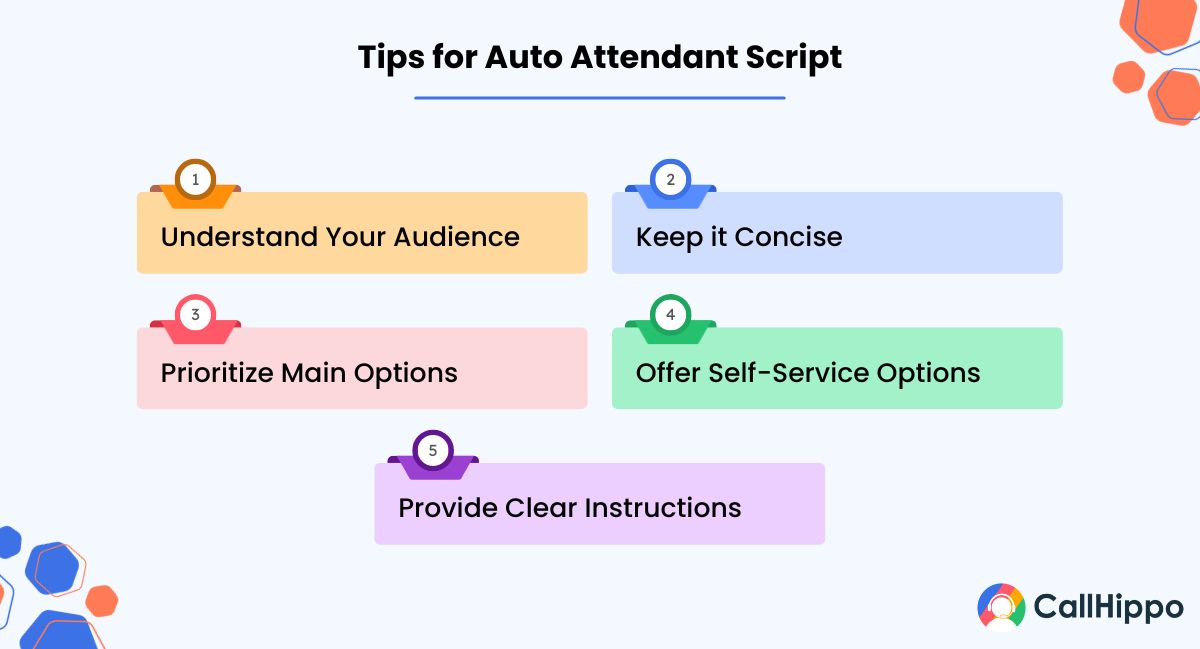
1. Understand Your Audience
Before you start writing the script, it’s essential to understand your callers. Consider their demographics, needs, and preferences. Tailor your script to cater to the expectations of your target audience.
2. Keep it Concise
Brevity is key in an auto-attendant script. Keep your prompts and messages concise and to the point. Avoid lengthy introductions or overly complex language. The goal is to guide callers efficiently.
3. Prioritize Main Options
Place the most commonly used options at the beginning of the script. For example, “Press 1 for Sales” or “Press 2 for Customer Support.” This ensures that callers can quickly access the most sought-after services.
4. Offer Self-Service Options
Allow callers to complete basic tasks without the need for human intervention. Include options like checking account balances, order status, or tracking information. This saves time for both callers and your staff.
5. Provide Clear Instructions
Use clear and friendly language to instruct callers on how to navigate the system. For example, “Press 3 to speak with a representative” or “Say ‘billing’ for billing inquiries.”
Auto Attendant Script Examples
Here are 15 detailed auto attendant script examples for various scenarios:
1. Basic Business Auto Attendant
“Thank you for calling [Your Company Name]. For Sales, press 1. For Customer support team, please press 2. To speak with an operator, press 0. To hear our business hours, press 3.”
2. Medical Office Auto Attendant
“Welcome to [Medical Practice Name]. To schedule an appointment, press 1. For billing inquiries, press 2. To reach our nursing staff, press 3. For directions to our office, press 4. To speak with a receptionist, press 0.”
3. Law Firm Auto Attendant
“You’ve reached [Law Firm Name]. To speak with an attorney, press 1. For billing and account information, press 2. To schedule a consultation, press 3. For our office location and hours, press 4. To speak with our receptionist, press 0.”
4. Technical Support Auto Attendant
“Thank you for contacting [Tech Support Company]. To troubleshoot an issue, press 1. For account-related inquiries, press 2. To inquire about our service plans, press 3. For general information, press 4. To speak with a technician, press 0.”
5. Hotel Auto Attendant
“Welcome to [Hotel Name]. To make a reservation, press 1. For current room rates, press 2. To inquire about our amenities, press 3. For directions to our hotel, press 4. To speak with our front desk, press 0.”
6. Voicemail Auto Attendant Greetings for Personal Use
“Hello, you’ve reached [Your Name]. I’m unable to take your call right now, but your message is important. Please leave your name, number, and a brief message, and I’ll get back to you as soon as possible. Thank you.”
7. Restaurant Auto Attendant
“Thank you for choosing [Restaurant Name]. To make a reservation, press 1. For our daily specials, press 2. For takeout orders, press 3. To speak with a host/hostess, press 0. “
8. Educational Institution Auto Attendant
“Welcome to [School/University Name]. For admissions, press 1. For academic advising, press 2. For student services, press 3. To hear our address and office hours, press 4. For the main directory, press 0.”
9. Nonprofit Organization Auto Attendant
“Thank you for reaching out to [Nonprofit Name]. To make a donation, press 1. For volunteer opportunities, press 2. To learn more about our mission, press 3. To speak with a representative, press 0.”
10. Insurance Company Auto Attendant
“You’ve reached [Insurance Company Name]. To file a claim, press 1. For policy information, press 2. To inquire about premiums and billing, press 3. For company information, press 4. To speak with a representative, press 0.”
11. Government Office Auto Attendant
“Welcome to [Government Office Name]. For department directory, press 1. To report an issue or concern, press 2. For office hours and location, press 3. To speak with a receptionist, press 0.”
12. Real Estate Agency Auto Attendant
“Thank you for contacting [Real Estate Agency Name]. To schedule a property viewing, press 1. For listings and pricing, press 2. For inquiries about selling your property, press 3. To speak with an agent, press 0.”
13. Financial Institution Auto Attendant
“Welcome to [Bank/Credit Union Name]. To check your account balance, press 1. For loan and mortgage inquiries, press 2. For card services, press 3. For our branch locations and hours, press 4. To speak with a representative, press 0.”
14. E-commerce Customer Support Auto Attendant
“Thank you for shopping with [E-commerce Store Name]. To track an order, press 1. For returns and exchanges, press 2. To inquire about product availability, press 3. For general inquiries, press 4. To speak with a support agent, press 0.”
15. Emergency Services Auto Attendant
“You’ve reached [Emergency Services Name]. For police assistance, press 1. For medical emergencies, press 2. For fire or rescue services, press 3. For all other inquiries, press 0. In case of a life-threatening emergency, please hang up and dial 911.”
Remember to adapt these scripts to your specific needs, and always consider the caller’s ease of navigation and the importance of a clear, concise, and professional tone in your auto attendant script.
You May Also Read : New Cold Calling Scripts + [ Free Template Download ]
How to Make Your Own Auto Attendant Script?
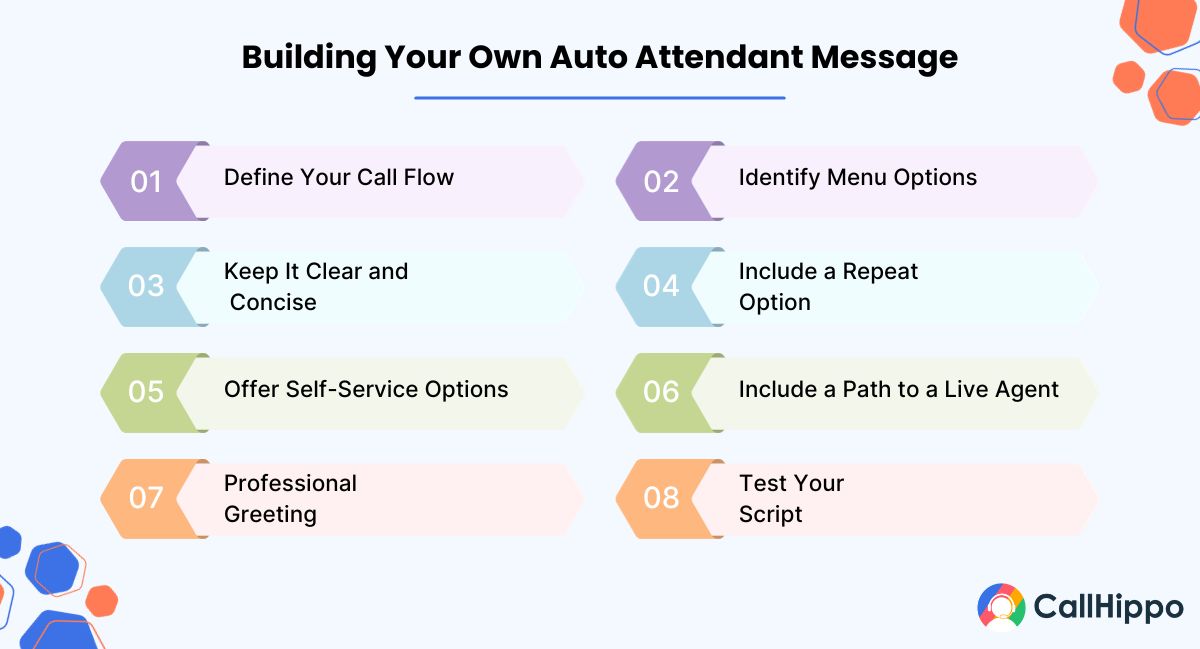
Here are the effective and tested steps for making your own auto attendant script –
1. Define Your Call Flow
Begin by outlining the call flow. Understand the main reasons callers might contact your organization, such as sales inquiries, customer support, or general information. This forms the backbone of your script.
2. Identify Key Menu Options
Based on your call flow, identify the key menu options. For example, “Press 1 for Sales,” “Press 2 for Support,” and so on. Prioritize the most frequently requested services at the beginning of the menu.
3. Keep It Clear and Concise
Your script should be easy to understand. Use simple language and avoid jargon or technical terms. Keep prompts short and to the point. Long-winded explanations can frustrate callers.
4. Include a Repeat Option
After presenting the menu options, provide a repeat option like “To hear these options again, press 9.” This helps callers who missed the initial choices.
5. Offer Self-Service Options
Incorporate self-service options for common queries. These might include checking account balances, tracking orders, or accessing FAQs. This can reduce the workload on live agents.
6. Include a Path to a Live Agent
Always provide a way for callers to speak with a live agent. Whether it’s by pressing “0” or saying “agent,” this ensures customers can get help when needed.
7. Professional Greeting
Start with a warm and professional greeting like, “Thank you for calling [Your Company Name].” It sets the tone for the call and makes a positive impression.
8. Test Your Script
Before deploying the script, thoroughly test it. Ensure that all options work correctly, and listen to the script from a caller’s perspective to identify any issues.
Common Mistakes to Avoid in Auto Attendant Scripts
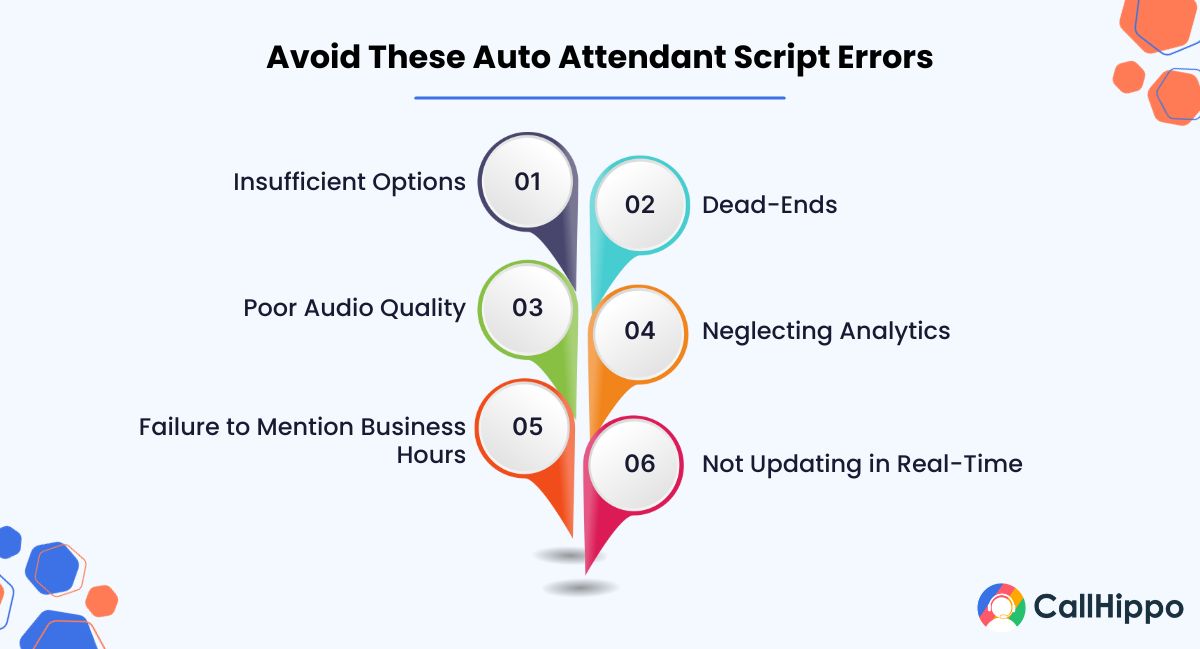
Avoiding common mistakes in auto attendant scripts is essential to provide callers with a positive and efficient experience. Here are several prevalent errors to steer clear of –
1. Insufficient Options
Not providing enough menu options can lead to frustration for callers who may have specific needs. Ensure that your script covers the most common reasons for calling and offers a comprehensive menu of options to address various inquiries or requests.
2. Dead-Ends
Failing to provide an option for callers to reach a live agent or return to the main menu can be a major oversight. Dead-end options leave callers feeling trapped in the system and can lead to dissatisfaction. Always offer an escape route or a way to speak with a human representative.
3. Poor Audio Quality
Ensure that your recorded messages are of high audio quality. Poor audio can make it difficult for callers to understand the menu options, leading to frustration and errors in navigation.
4. Neglecting Analytics
After implementing your auto attendant script, don’t neglect to monitor call analytics. Analyzing call data can help you identify bottlenecks, frequent drop-off points, or issues in the script’s flow. Use this data to make necessary improvements to enhance the caller experience.
5. Failure to Mention Regular Business Hours
If applicable, failing to mention your normal business hours or holiday schedules can leave callers uncertain about when they can reach your organization. Including this information helps manage caller expectations and avoids unnecessary frustration.
6. Not Updating in Real-Time
In cases of unexpected closures or events, such as holidays or emergencies, failing to update your auto attendant script in real-time to inform callers can lead to confusion and dissatisfaction. Regularly review and update your script as needed to reflect changes accurately.
Upgrade Your Phone System With CallHippo
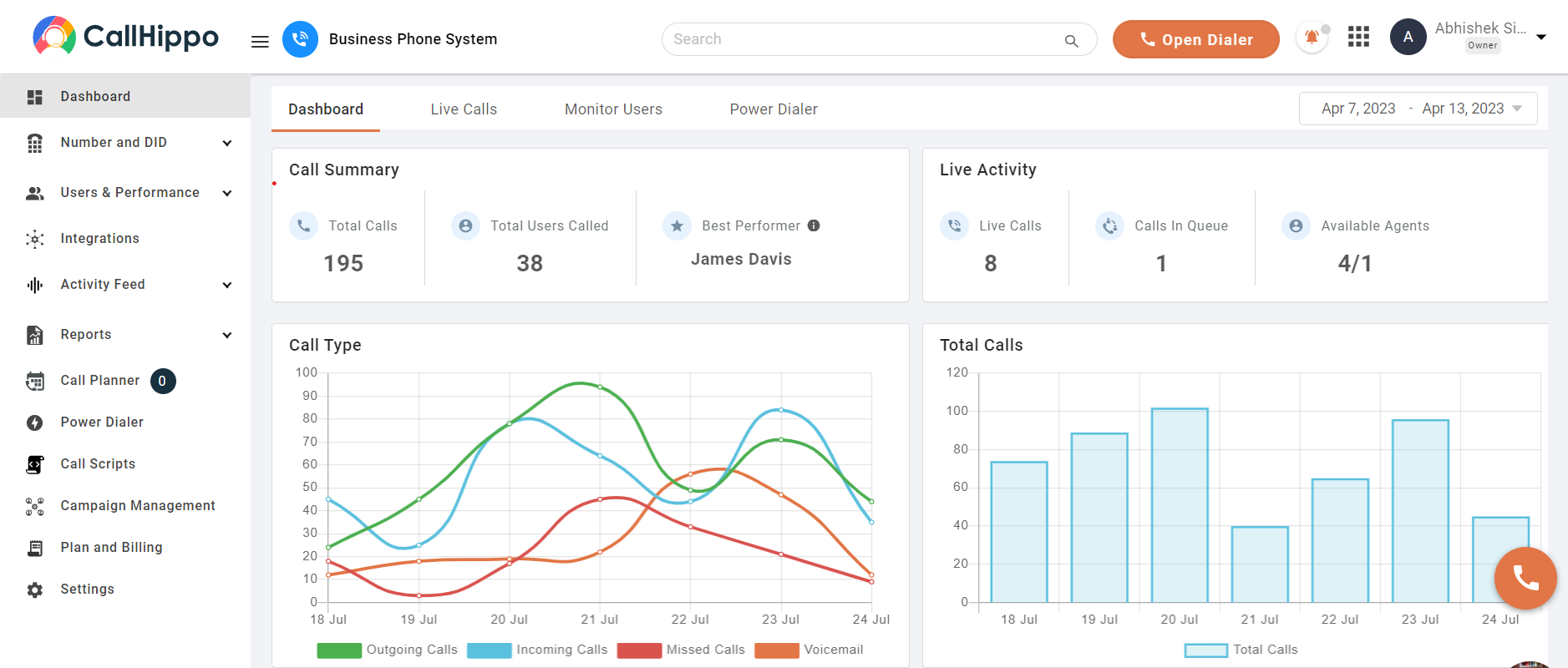
Upgrading your phone system with CallHippo offers a comprehensive and feature-rich solution to meet the evolving communication needs of your support and sales department. CallHippo is a modern cloud-based phone system that not only enhances your company’s professionalism but also optimizes your communication processes. With CallHippo, you can seamlessly manage phone calls, improve customer interactions, and increase productivity across your organization.
One of the key advantages of upgrading to CallHippo is its scalability. Whether you’re a small startup or a large enterprise, CallHippo’s flexible plans can be tailored to your specific requirements, allowing your phone system to grow with your business. It offers features such as virtual phone numbers, call routing, and call recording, enabling you to streamline your communication efforts.
Key features
- Power dialer
- Interactive Voice Response (IVR)
- Automatic Call Distribution (ACD)
- Call forwarding
- Smart Switch
- Call barging software
- Voicemail
- Call hold audio
Pricing & Plans
Starter – $16 per user per month
Professional – $28 per user per month
Ultimate – $40 per user per month
Less Than 3 Minutes
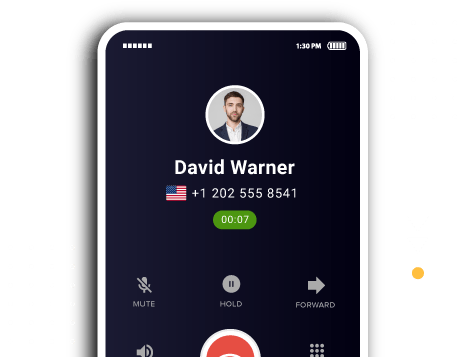
Final Thoughts
Upgrading your phone system with CallHippo is a strategic move to elevate your organization’s communication capabilities. With its scalability and an array of advanced features, CallHippo empowers your business to operate more efficiently and professionally.
This cloud-based phone system not only enhances customer interactions but also simplifies internal communication, ultimately contributing to increased productivity and overall success. Embracing the future of communication technology with CallHippo is a step towards ensuring that your business remains agile and responsive to the ever-evolving demands of the modern business landscape.
FAQ
How much does an auto attendant cost?
The cost of an auto attendant system can vary significantly based on factors such as the provider, features, and the scale of your business. Prices can range from $50 to more substantial monthly fees for advanced options. It’s best to consult with providers directly to get precise pricing tailored to your needs.
Why is an auto attendant script important for businesses?
An auto attendant script is essential for businesses because it serves as the virtual front door to your organization. It ensures callers can efficiently navigate your phone system, find the information or assistance they need, and provides a professional and consistent image to callers. A well-crafted script enhances customer service, streamlines internal communication, and contributes to a positive caller experience.

Subscribe to our newsletter & never miss our latest news and promotions.
![10+ Auto Attendant Script Examples [Free Templates] 10+ Auto Attendant Script Examples [Free Templates]](https://callhippo.com/blog/wp-content/uploads/2023/09/auto-attendant-script.jpg)








